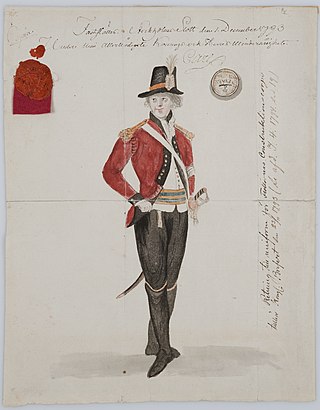- Tunic (Vapenrock m/11) with armband
- Private
- Company commander
- Battalion commander
- Cap (Mössa m/1926) with battalion commander's rank insignia.
- The yellow cross on a blue background distinguished the landstorm
History

In Sweden, since ancient times, every man fit for military service has been used to take up arms and participate in the defence of the kingdom when the enemy threatened or ravaged the country, upon the call of the King. The 19th century's efforts to rearrange the Swedish military order based on conscription led to the need for a fixed landstorm organization. [1] However, it wasn't until 9 May 1885, that the Riksdag passed a conscription law to organize the landstorm. [2] The six oldest classes of conscripts (ages 27-32) came to form the landstorm. Through the 1892 Army Order, the landstorm expanded to include the eight oldest classes, and the landstorm age range was raised to 33-40 years of age. [1]
The landstorm was subordinate to the enlistment district commanders, and each enlistment district was usually divided into six landstorm districts, each under an officer in the reserve (in the absence of another person) assisted by a non-commissioned officer in the reserve as a manager of the landstorm storehouses available there. Voluntary exercises with the landstorm command were organized to the extent of available funds. The landstorm was assembled first in the event of war, and then in the parts of the country most threatened by the enemy. It was organized according to existing conditions and provided with commanders based on advice and quarters. [3] The commanders of the landstorm units were mainly recruited on a voluntary basis. [1]
According to the Defence Act of 1914 , the landstorm included men aged 35-42, and conscripts belonging to the landstorm were subjected to mandatory training of five days during peacetime. However, such training took place only a short time after the adoption of the defence act. Under the Defence Act of 1925, the landstorm continued to be formed by the eight oldest classes (35-42 years of age), but no peacetime training occurred. The King could, after a decision was made to call up the first levy of conscripts and when the defence or security of the realm required it, call up the landstorm for the defence of their local area. However, special departments for protection of mobilization could be called upon before that, but they could not be kept together for longer than a maximum of 15 days. The landstorm was not allowed outside its own or neighboring enlistment district. [1]
In accordance with the Defence Act of 1936, the landstorm was extended to include the 11 oldest classes (35-45 years of age). Peacetime training now consisted of a landstorm rehearsal exercise of five days for the majority of conscripts and, immediately before this, a landstorm command exercise of seven days for trained commanders and others. The previously applicable regulations, stating that the landstorm could not be taken outside its own or neighboring enlistment district, were repealed. The landstorm received increased tasks, including serving in territorial air defence and providing air surveillance. Additionally, the landstorm would make up the infantry of the coastal fortifications, and some engineering and service units would be organized. [1]
According to the Defence Reform of 1901 and continuing until the Defence Act of 1942 , the Swedish mainland was divided into landstorm districts to account for and organize the landstorm. Each landstorm district had a landstorm district commander, and for those landstorm districts where storehouses were established, there was also a landstorm förvaltare [lower-alpha 1] . With the implementation of the Conscription Act of 1941, the division of conscripts into beväringen and the landstorm was abolished. [1]











